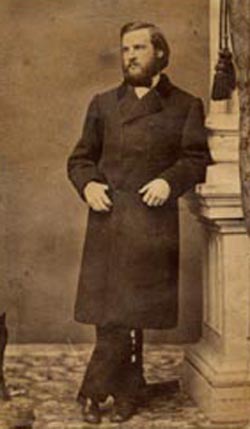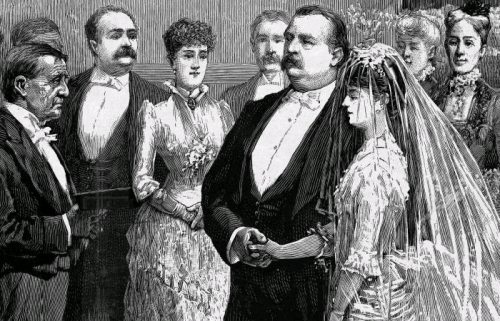President Cleveland’s Problem Child
Not even a specific allegation of philandering, illicit pregnancy and coverup barred Grover Cleveland from the White House
/https://tf-cmsv2-smithsonianmag-media.s3.amazonaws.com/filer/Past-Imperfect-Cleveland-child.jpg)
“It seems to me that a leading question ought to be: do the American people want a common libertine for their president?” So wrote a preacher from Buffalo, New York, to the editor of the Chicago Tribune on the eve of the 1884 presidential election.
Maine Senator James G. Blaine, the Republican candidate, had been shamed some years earlier when it came to light that he’d been trading congressional favors for cash, something his Democratic rivals brought up at every opportunity. The Democrats, though, had troubles of their own. A scandalous tale about the misdeeds of their candidate, New York Governor Grover Cleveland, was gaining traction, along with a particularly grating chant directed at him: “Ma, ma, where’s my Pa?”
For on July 21, 1884, the Buffalo Evening Telegraph broke a story many in upstate New York had long known to be true—that 10 years earlier, a woman named Maria Halpin had given birth in that city to a son with the surname Cleveland and then been taken to a mental asylum while the child was adopted by another family.
Cleveland’s campaign, knowing there was no refuting the allegations, was almost blasé in admitting that yes, Cleveland and Halpin had been “illicitly acquainted.” At the time, the campaign provided this rationale: Cleveland was a bachelor, and Halpin had been rather free with her affections, including with some of Cleveland’s friends—prominent Buffalo businessmen all. As the only unmarried man of the bunch, Cleveland, though not certain the child was his, claimed paternity and helped Halpin name the boy and place him with a caring family. Really, he’d been looking out for his friends and for a woman in unfortunate circumstances. The scandal was, of course, unfortunate, but the governor’s involvement was far from nefarious, and certainly shouldn’t preclude him from serving as president (especially not when Blaine had already made it clear he was not a man to be trusted).
Nevertheless, newspapers ran with the story, and it was only a matter of time before reporters discovered Halpin’s whereabouts. Her tale differed from Cleveland’s, substantially.
In an October 31, 1884, interview with the Chicago Tribune, she proclaimed, “The circumstances under which my ruin was accomplished are too revolting on the part of Grover Cleveland to be made public.”
Halpin was a 38-year-old widow in 1874, according to the Tribune, which also reported:
Halpin said that Cleveland had pursued her relentlessly, and that she finally consented to join him for a meal at the Ocean Dining Hall & Oyster House. After dinner, Cleveland escorted her back to her boarding house. In an 1874 affidavit, Halpin strongly implied that Cleveland’s entry into her room and the incident that transpired there was not consensual—he was forceful and violent, she alleged, and later promised to ruin her if she went to the authorities.
Halpin said she told Cleveland she never wanted to see him again, but “five or six weeks later” was forced to seek him out because she was in the kind of trouble only Cleveland could help her with.
The trouble, of course, was pregnancy.
Nine months later, Halpin’s son was born and promptly removed from her custody. Halpin was admitted under murky circumstances to a local asylum for the insane. Doctors from that institution, when interviewed by the press during the 1884 campaign, corroborated Halpin’s insistence that she was not, in fact, in need of committing. The Chicago Daily Tribune reported:
Dr. William G. King, an honored citizen of Buffalo, was then attending physician at the Providence Asylum. When visited by a Telegraph reporter last week he said that he remembered Maria Halpin well. He says she was brought to the asylum without warrant or form of law. When he examined her he found that she was not insane, though she had been drinking. The managers of the asylum had no right to detain her, and she left in a few days—that is, as soon as she chose to after her terrible experience.
Upon her release, Halpin’s first order of business was to locate her son, who had been “spirited away” after she was taken to the asylum.
Halpin contacted Milo A. Whitney, a well known Buffalo attorney, and announced her intent to charge Cleveland with assault and abduction:
Whitney says Maria Halpin came to consult him about instituting proceedings against all concerned in the assault and abduction. She said she knew that Grover Cleveland had plotted the abduction and hired the men to carry it out, as he had previously tried less violent means to deprive her of the child and get her out of the way.
Shortly after Halpin’s initial meeting with Whitney, her brother-in-law arrived from New Jersey to offer assistance. Days later, the pair called at Whitney’s office with a document that would seem to resolve the whole business:
They showed the attorney an agreement which stipulated that upon the payment of the sum of $500, Maria Halpin was to surrender her son, Oscar Folsom Cleveland, and make no further demands of any nature whatever upon his father.
Whitney maintained in all subsequent interviews that the document was in Grover Cleveland’s handwriting.
Oscar Folsom Cleveland (given the middle name Folsom after Oscar Folsom, Cleveland’s closest friend) was adopted by the Providence Asylum’s Dr. King and raised in Buffalo separate from his birth mother.
When interviewed in 1884 and asked about Cleveland’s assertion that any number of men could have been Oscar’s father, Halpin was outraged: “There is not and never was a doubt as to the paternity of our child, and the attempt of Grover Cleveland or his friends to couple the name of Oscar Folsom or any one else with that of the boy, for that purpose, is simply infamous and false.”
Halpin was living in New Rochelle, New York, just outside New York City, and breathless accounts of her looks and disposition filled the pages of the New-York World:
Mrs. Halpin is still an attractive woman, and although said to be 45 or 50, does not look more than 35. A wealth of dark hair and dark eyes of great depth and of strange, fascinating power are in strong contrast to a pale, clear complexion while regular features, and rounded chin, and a classically-cut and curved mouth could not fail to make a pleasant impression on those with whom she came in contact. Although robust, her form still preserves its symmetry, and this rotundity of figure rather adds to her matured charms than otherwise.
The story filled major newspapers during the summer and autumn of 1884—had Cleveland really taken part in the “seduction and ruination” of such a goodly woman? Was he indeed too much of a libertine to lead the nation? Or was his campaign telling the truth—that Maria Halpin was a harlot looking to cash in on a distant dalliance with the upstanding lawyer running for office on a clean-government ticket?
Most observers seemed to agree that Cleveland bore some degree of guilt. Writing to the Buffalo Evening Telegraph in the fall of 1884, Pastor Henry W. Crabbe, of that city’s United Presbyterian Church, condemned Cleveland resolutely:
I am very sorry to say that he is a corrupt, licentious man. He has never been married, and is notoriously bad with women. Cleveland is well known here, and it is a reproach to the city that he ever got into the Gubernatorial chair. I most sincerely and earnestly pray that he will not be our next President. His public life is revealing his true character. It may be said these stories are put in circulation for political effect, but the trouble is they cannot be refuted.
Still, Cleveland was not without defenders—including the famed reformer Henry Ward Beecher, who stood by the candidate in the pages of the Sunday Mercury, a Democratic-leaning newspaper:
Indeed, many of Cleveland’s supporters wrote the affair off as a young man’s folly—even though the man was nearly 40 years old when he became acquainted with Halpin.
In the end, Cleveland’s personal life proved more palatable to voters than Blaine’s political indiscretions: The Democrat won the election, carried by a New York state victory with a margin of barely 2,000 votes. The chant of “Ma, ma, where’s my Pa?” was answered by Democrats: “Gone to the White House, ha ha ha!”
The scandal was soon replaced on the front pages by breathless coverage of Cleveland’s new bride. Frances Folsom, daughter of the president’s best friend, became the first woman to be married in the White House and, at 21 (27 years younger than her husband), the nation’s youngest-ever first lady.
Oscar Folsom Cleveland faded from public record and seems to have come of age in privacy; some people believe he changed his name and became James E. King Jr., a Buffalo gynecologist who died childless in 1947.
Maria Halpin remarried and lived in relative obscurity until her death in 1902, and she seemed to take solace in her privacy to the last. According to her obituary, her last wish was that her funeral should not be public, “for she dreaded having strangers look curiously upon her dead face.”
Sources:
THE DEFENSE.: A Man of 40 Lusty Summers “Sowing His Wild Oats”, Chicago Daily Tribune, 13 August 1884; THE CLEVELAND SCANDAL: A Fresh Scrutiny of the Charges Affecting the New York Governor, Chicago Tribune, 31 October 1884; THE CLEVELAND SCANDAL.: WHAT THREE BUFFALO CLERGYMEN SAY OF GROVER CLEVELAND–WILL ANY CLERGYMAN TESTIFY ON THE OTHER SIDE?, Chicago Daily Tribune, 11 August 1884; THE CHARGES SWEPT AWAY, New-York Times, 12 August, 1884; CORROBORATION.: A PHYSICIAN’S STATEMENT. SEEKING REDRESS. MR. WHITNEY’ Chicago Daily Tribune, 19 September 1884; CLEVELAND.: History of Wicked Maria Halpin; Chicago Daily Tribune, 13 August 1884; PASSING OF MARIA HALPIN; The Atlanta Constitution, 8 February 1902; Lachman, Charles, A Secret Life: The Sex, Lies, and Scandals of President Grover Cleveland, Skyhorse Publishing, 2011; Presidential Election of 1884 Resource Guide, Library of Congress; Nevins, Allan, Grover Cleveland: A Study in Courage, Dodd/Mead, 1934.


